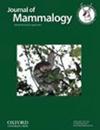Beta diversity patterns in Andean rodents: current and historical factors as drivers of turnover and nestedness
IF 1.6
3区 生物学
Q2 ZOOLOGY
引用次数: 0
Abstract
The Andes are known to be one of the most species-rich regions on Earth, with their origination promoting formation of new habitats and acting as climatic barriers. This orogenic event was structured latitudinally with 3 major segments having different formation times and with different environmental and historical conditions. The Andean region has been historically important in the evolutionary history of small mammals and is considered the region of Earth with the highest values of rodent species richness and turnover. Therefore, the region provides an excellent opportunity to evaluate mechanisms involved in structuring rodent assemblages and beta diversity patterns. Here, we assessed spatial patterns of rodent beta diversity along the Andes Mountains, with specific goals of examining patterns of turnover and nestedness as 2 recognized processes that drive species composition. We explored the role of spatial, climate, and historical factors on beta diversity patterns using geographic range maps for 432 rodent species to construct a species presence–absence matrix. We used piecewise regressions to identify latitudinal breakpoints in turnover and nestedness, and conducted multiple regressions and variation-partitioning approaches to assess the contribution of each set of postulated drivers in shaping beta diversity patterns. Beta diversity decreases from north to south. The highest turnover was located at the Northern Andes (5°N and 10°S) and western-central Andes (20°S and 35°S). Nestedness was higher below 40°S and in some areas of the western-central Andes between 15° and 20°S. Turnover and nestedness registered breakpoints coincident with the Central and Southern Andes limit. Turnover explained most of the beta diversity for all segments, although within the Southern Andes there was also some contribution of nestedness. In all segments, beta diversity was mainly explained by spatial factors with minor contributions from spatially structured climate (Northern Andes), interaction of all factors (Central Andes), and the interaction between current climate and history (Southern Andes).安第斯啮齿动物的 Beta 多样性模式:作为更替和嵌套驱动因素的当前和历史因素
众所周知,安第斯山脉是地球上物种最丰富的地区之一,其起源促进了新栖息地的形成,并成为气候屏障。这一造山运动在纬度上分为三个主要部分,形成时间不同,环境和历史条件也不同。安第斯地区在小型哺乳动物的进化史上具有重要的历史意义,被认为是地球上啮齿动物物种丰富度和更替率最高的地区。因此,该地区为评估啮齿动物群结构和贝塔多样性模式的相关机制提供了极好的机会。在这里,我们评估了安第斯山脉沿线啮齿动物贝塔多样性的空间模式,具体目标是研究物种更替和嵌套模式这两个公认的驱动物种组成的过程。我们利用 432 种啮齿动物的地理分布图构建了物种存在-不存在矩阵,探讨了空间、气候和历史因素对贝塔多样性模式的作用。我们使用片断回归来确定更替和嵌套的纬度断点,并采用多元回归和变异分区方法来评估每一组假定的驱动因素在形成贝塔多样性模式中的贡献。贝塔多样性从北向南递减。北安第斯山脉(北纬 5 度和南纬 10 度)和中西部安第斯山脉(南纬 20 度和南纬 35 度)的更替率最高。在南纬 40 度以下以及南纬 15 度至 20 度之间的安第斯山脉中西部某些地区,嵌套度较高。周转率和嵌套度的断点与中安第斯山脉和南安第斯山脉的界限相吻合。虽然在南安第斯山区,嵌套也有一定的作用,但所有地段的贝塔多样性大部分是由更替造成的。在所有地段,贝塔多样性主要由空间因素解释,空间结构气候(北安第斯山脉)、所有因素的相互作用(中安第斯山脉)以及当前气候与历史之间的相互作用(南安第斯山脉)对贝塔多样性的解释作用较小。
本文章由计算机程序翻译,如有差异,请以英文原文为准。
求助全文
约1分钟内获得全文
求助全文
来源期刊

Journal of Mammalogy
生物-动物学
CiteScore
3.30
自引率
5.90%
发文量
106
审稿时长
4-8 weeks
期刊介绍:
Papers are published on mammalian behavior, conservation, ecology, genetics, morphology, physiology, and taxonomy.
 求助内容:
求助内容: 应助结果提醒方式:
应助结果提醒方式:


